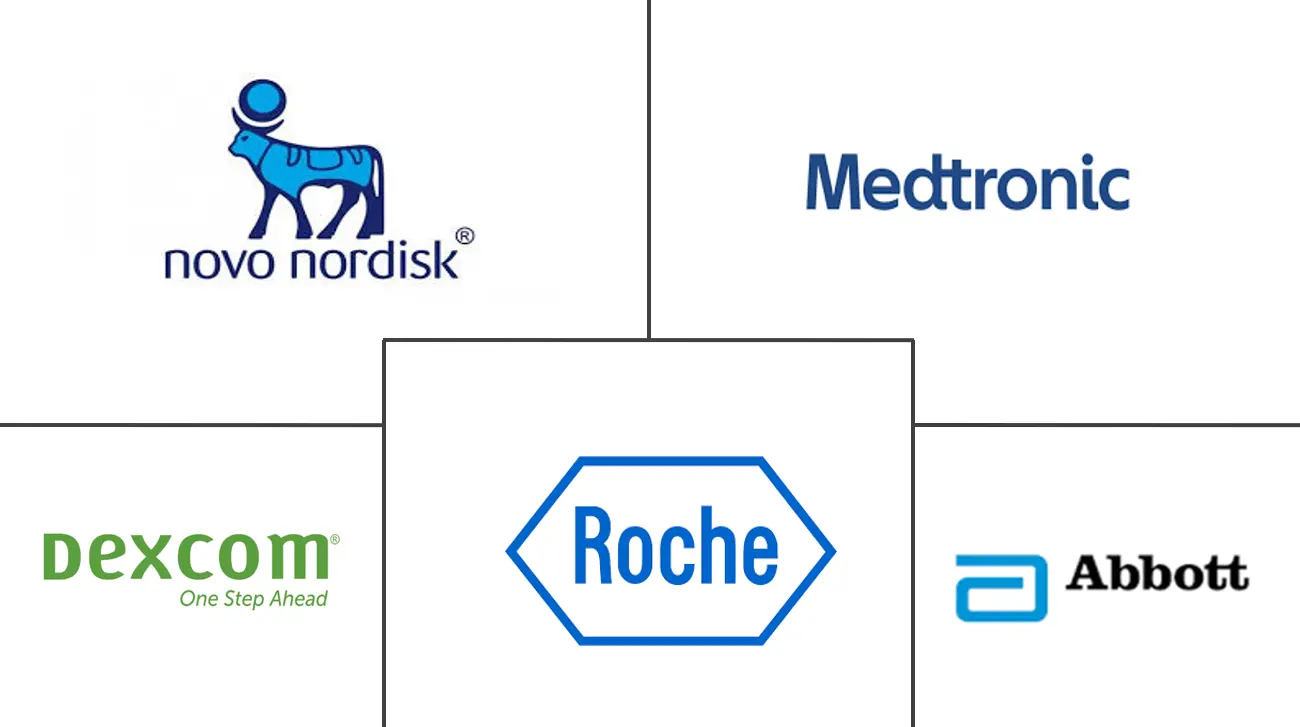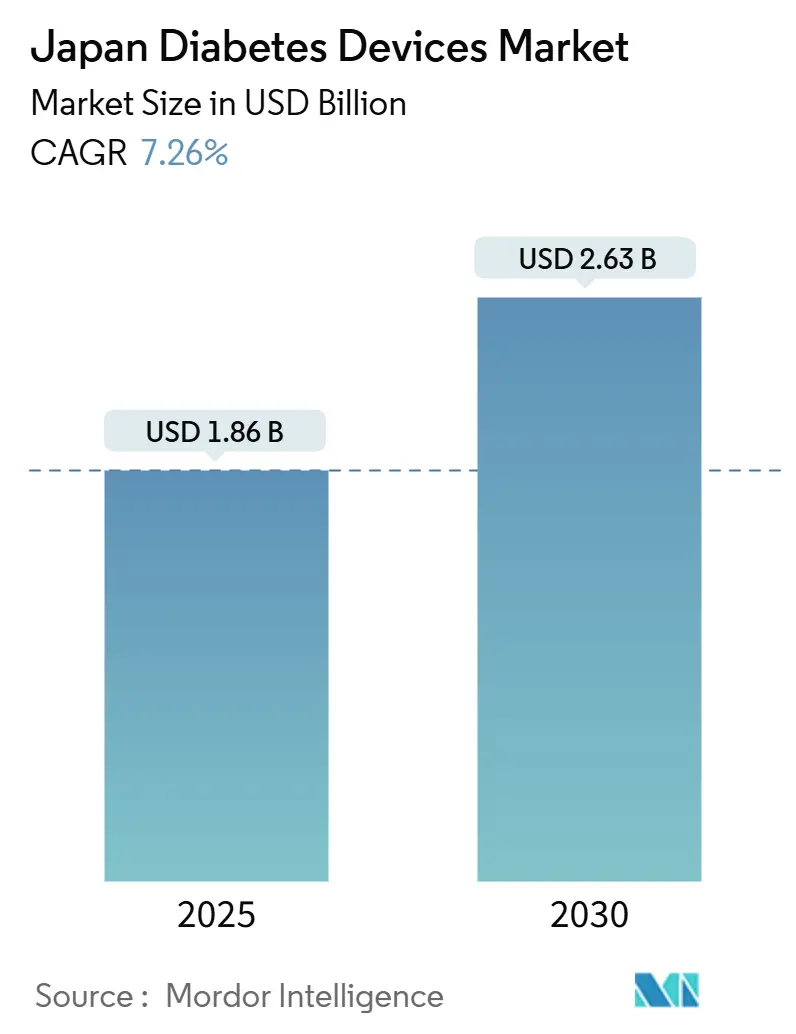
Japan Diabetes Devices Market Analysis by Mordor Intelligence
The Japan Diabetes Devices Market size is estimated at USD 1.86 billion in 2025, and is expected to reach USD 2.63 billion by 2030, at a CAGR of 7.26% during the forecast period (2025-2030).
The Japan Diabetes Devices Market size is estimated at USD 1.86 billion in 2025, and is expected to reach USD 2.63 billion by 2030, at a CAGR of 7.26% during the forecast period (2025-2030).
An immune system malfunction causes type 1 diabetes, and Type 2 diabetes is linked to leading a sedentary lifestyle, which results in the development of inherent resistance to insulin. Hence, Type 1 diabetes can be characterized as insulin-requiring, while Type 2 diabetes can be described as insulin-dependent diabetes.
Japan has one of the largest elderly populations in the world, which is more susceptible to the onset of type 2 diabetes. As Japan's population continues to age, the prevalence of diabetes increases as well. The monitoring and management of blood glucose levels are on the rise, as they help avoid negative consequences, such as cardiovascular diseases, kidney disorders, and many other conditions.
The rising prevalence of diabetes in Japan has become a significant health concern, driving the demand for diabetes devices. With lifestyle changes, including sedentary behavior, unhealthy eating habits, and an aging population, Italy has witnessed a steady increase in the number of individuals diagnosed with diabetes. According to recent statistics, japan ranks among the Asia countries with a high prevalence of diabetes, with both type 1 and type 2 diabetes contributing to the burden of the disease.
As the diabetes population continues to grow in Japan, there is a parallel surge in the need for effective management and treatment options. Diabetes devices play a crucial role in controlling blood sugar levels and preventing complications associated with diabetes. These medications are favored by many patients due to their convenience, ease of administration, and ability to improve glycemic control.
The demand for diabetes devices reflects the necessity for accessible and efficient treatments to combat the escalating diabetes epidemic in Japan.
Japan Diabetes Devices Market Trends and Insights
The continuous glucose monitoring segment is expected to witness the highest growth rate over the forecast period
To use a CGM, a small sensor is inserted into the abdomen or arm with a tiny plastic cannula penetrating the top skin layer. An adhesive patch holds the sensor in place, allowing it to take glucose readings in interstitial fluid throughout the day and night. Generally, the sensors must be replaced every 7 to 14 days. A small, reusable transmitter connected to the sensor allows the system to send real-time readings wirelessly to a monitor device that displays blood glucose data. Some systems contain a dedicated monitor, and some display the information via a smartphone app.
Continuous glucose monitoring sensors use glucose oxidase to detect blood sugar levels. Glucose oxidase converts glucose to hydrogen peroxidase, which reacts with the platinum inside the sensor, producing an electrical signal to be communicated to the transmitter. Sensors are the most important part of continuous glucose monitoring devices. Researchers are trying to find and develop alternatives to electrochemical-based glucose sensors and create more affordable, minimally invasive, and user-friendly CGM sensors. Optical measurement is a promising platform for glucose sensing.
Some technologies with high potential in continuous glucose sensing are reported, including spectroscopy, fluorescence, holographic technology, etc. Eversense, a CGM sensor based on fluorescence sensing developed by Senseonics Company, presents a much longer lifespan than electrochemical sensors. Technological advancements to improve the sensor's accuracy are expected to drive segment growth during the forecast period.
The frequency of monitoring glucose levels depends on the diabetes type, which varies from patient to patient. Type-1 diabetic patients need to check their blood glucose levels regularly to monitor their blood glucose levels and adjust the insulin dosing accordingly. The current CGM devices show a detailed representation of blood glucose patterns and tendencies compared to a routine check of glucose levels at set intervals.
Furthermore, the current continuous glucose monitoring devices can either retrospectively display the trends in blood glucose levels by downloading the data or give a real-time picture of glucose levels through receiver displays. Continuous glucose monitoring devices are becoming cheaper with new technologies, like cell phone integration. It is likely to drive the segment growth during the forecast period.
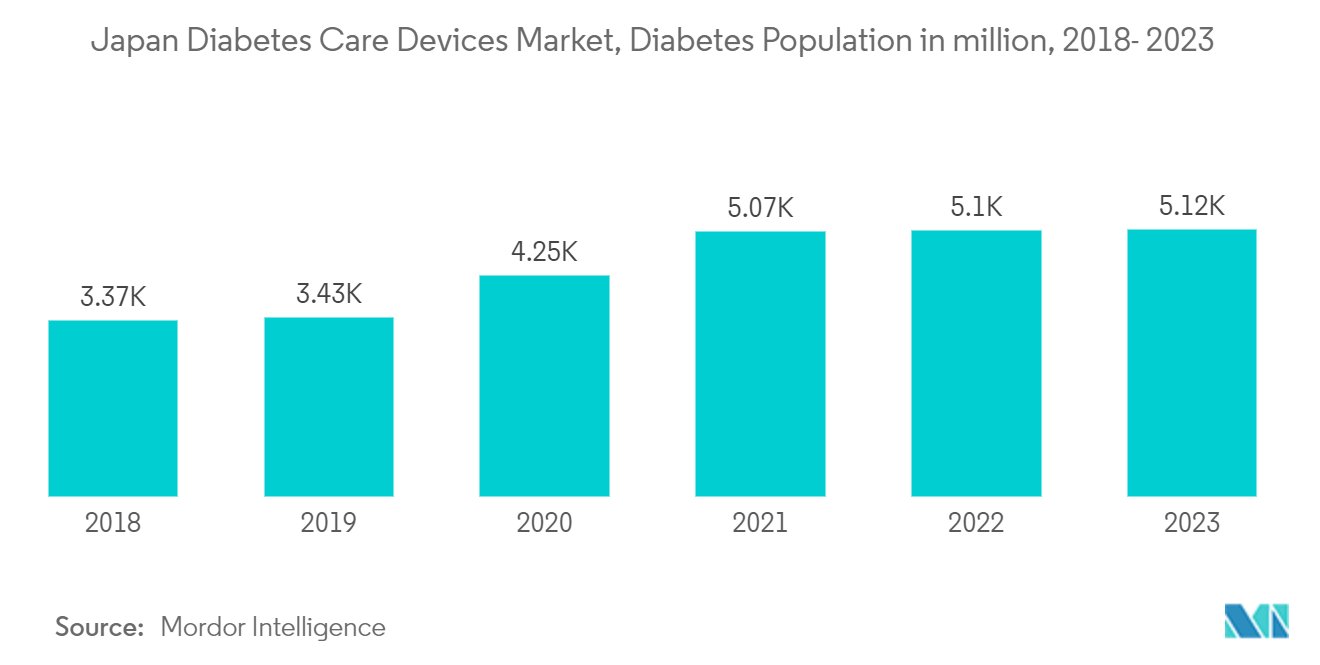
Insulin cartridges in reusable pens occupied the highest share in the management devices segment in the current year
Insulin cartridges in reusable pens occupied the highest market share of about 68% in the management devices segment in the current year.
Insulin cartridges in reusable pens are an upgraded version of insulin vials. Most types of insulins are manufactured in the form of cartridges, making them easily accessible. These devices include all the functional benefits of reusable pens and are cost-effective, as these cartridges are less expensive compared to disposable insulin pens in the long run.
Due to the increasing demand for insulin cartridges, most insulin device manufacturers produced reusable insulin pens compatible with various insulin manufacturers' cartridges. These insulin cartridges are considered more consumer-friendly, as they are smaller and less noticeable than the classic vial-and-syringe.
These devices are also more portable for consumers. Open cartridges do not need to be refrigerated, making storage easy for consumers. Thus, cartridges are the most cost-effective insulin use, as reusable pens are a one-time investment, unlike disposable pens.
Diabetes is identified as a healthcare priority by the Ministry of Health, Labour, and Welfare. The high prevalence of type 2 diabetes is associated with a significant economic burden. The costs of diabetes are increased in patients with co-morbidities such as hypertension and hyperlipidemia and in patients who develop complications.
Costs increase with an increasing number of complications. Well-organized medical insurance systems cover all medical fees for diabetes mellitus, and people with diabetes can visit doctors freely in Japan. Also, insulin therapy by self-injection became legal and is covered by health insurance. Such advantages helped the adoption of these products in the Japanese market.
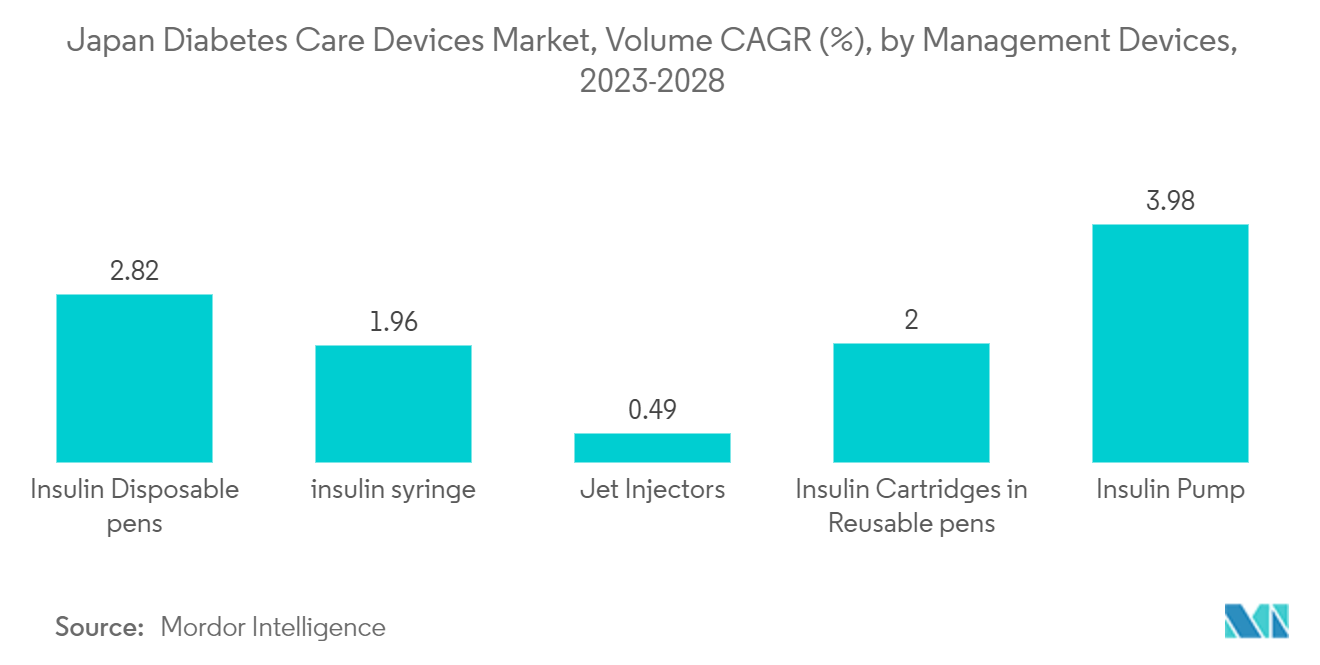
Competitive Landscape
The Japanese diabetes devices market is consolidated, with major manufacturers like Roche, Abbott, Novo Nordisk, Dexcom, Medtronic, etc., and other region-specific manufacturers.
Japan Diabetes Devices Industry Leaders
Abbott Diabetes Care
Medtronic PLC
Novo Nordisk A/S
Roche Diabetes Care
Dexcom Inc.
- *Disclaimer: Major Players sorted in no particular order
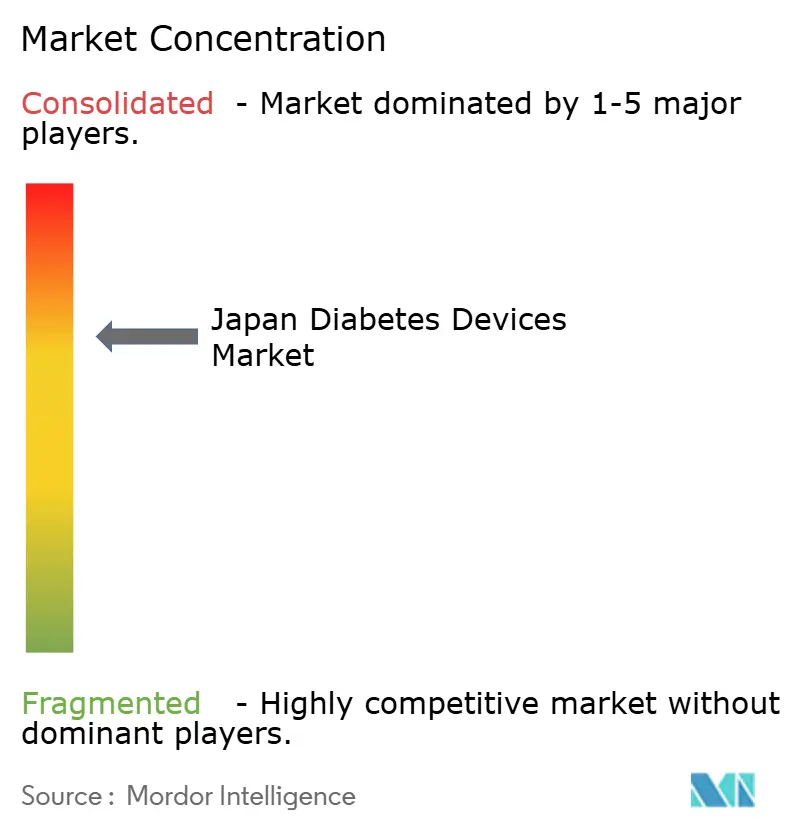
Recent Industry Developments
- May 2023: During the 66th Annual Meeting of the Japan Diabetes Society, Dexcom unveiled its Dexcom G6 CGM. The G6, which is now considered the previous-generation model following the introduction of the G7, incorporates a compact and wearable sensor. Additionally, it includes a transmitter that consistently measures and transmits glucose levels wirelessly to a smart device or receiver. This innovative system allows individuals with diabetes to effortlessly access real-time glucose data without the need for scanning or finger pricking.
- June 2022: Sanofi and Health2Sync announced they would work on new features, such as connected caps for insulin products. It would automatically record delivered doses, rather than requiring them to be logged manually, and titration alerts from the app to indicate when a change in insulin dose may be required.
Japan Diabetes Devices Market Report Scope
Diabetes care devices are the hardware, equipment, and software used by diabetes patients to regulate blood glucose levels, prevent diabetes complications, lessen the burden of diabetes, and enhance the quality of life. The Japan Diabetes Devices Market is segmented into management devices and monitoring devices. The report offers the Value (In USD) for the above segments.
| Insulin Pump | Technology | Tethered Insulin Pump |
| Tubeless Insulin Pump | ||
| Component | Insulin Pump Device | |
| Insulin Pump Reservoir | ||
| Infusion Set | ||
| Insulin pens | Cartridges in Reusable Pens | |
| Insulin Disposable Pens | ||
| Insulin Syringes | ||
| Jet Injectors | ||
| Self-monitoring Blood Glucose | Glucometer Devices |
| Blood Glucose Test Strips | |
| Lancets | |
| Continuous Glucose Monitoring | Sensors |
| Durables (Receivers and Transmitters) |
| Management Devices | Insulin Pump | Technology | Tethered Insulin Pump |
| Tubeless Insulin Pump | |||
| Component | Insulin Pump Device | ||
| Insulin Pump Reservoir | |||
| Infusion Set | |||
| Insulin pens | Cartridges in Reusable Pens | ||
| Insulin Disposable Pens | |||
| Insulin Syringes | |||
| Jet Injectors | |||
| Monitoring Devices | Self-monitoring Blood Glucose | Glucometer Devices | |
| Blood Glucose Test Strips | |||
| Lancets | |||
| Continuous Glucose Monitoring | Sensors | ||
| Durables (Receivers and Transmitters) | |||
Key Questions Answered in the Report
How big is the Japan Diabetes Devices Market?
The Japan Diabetes Devices Market size is expected to reach USD 1.86 billion in 2025 and grow at a CAGR of 7.26% to reach USD 2.63 billion by 2030.
What is the current Japan Diabetes Devices Market size?
In 2025, the Japan Diabetes Devices Market size is expected to reach USD 1.86 billion.
Who are the key players in Japan Diabetes Devices Market?
Abbott Diabetes Care, Medtronic PLC, Novo Nordisk A/S, Roche Diabetes Care and Dexcom Inc. are the major companies operating in the Japan Diabetes Devices Market.
What years does this Japan Diabetes Devices Market cover, and what was the market size in 2024?
In 2024, the Japan Diabetes Devices Market size was estimated at USD 1.72 billion. The report covers the Japan Diabetes Devices Market historical market size for years: 2019, 2020, 2021, 2022, 2023 and 2024. The report also forecasts the Japan Diabetes Devices Market size for years: 2025, 2026, 2027, 2028, 2029 and 2030.
